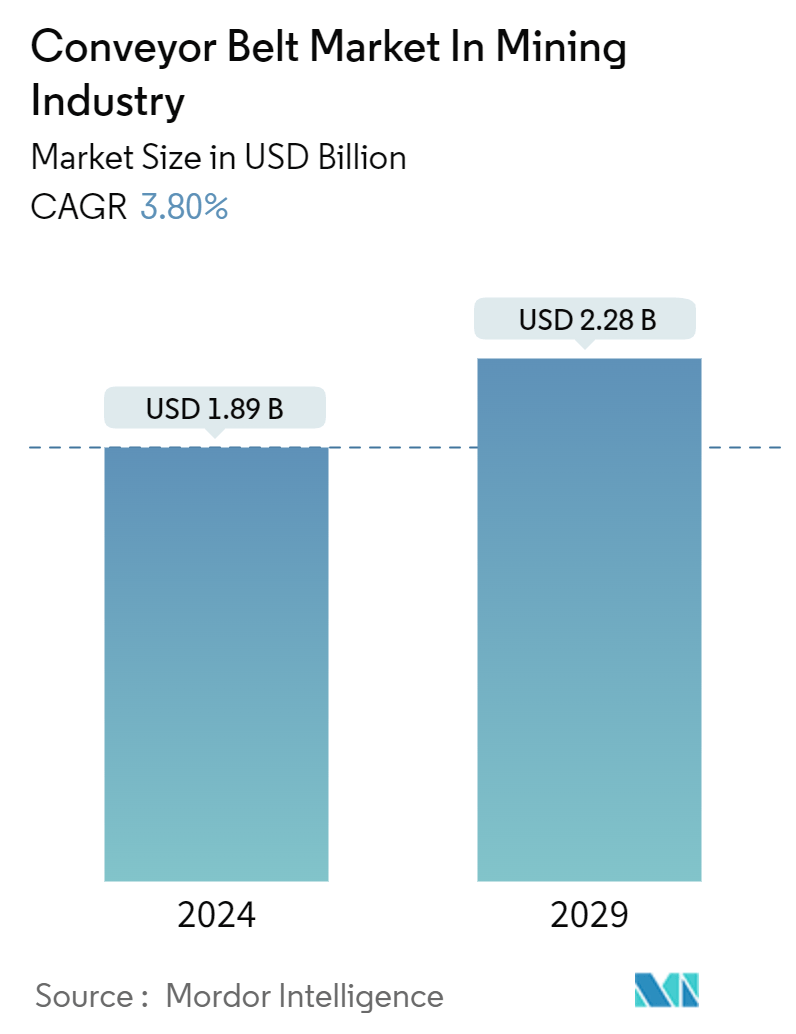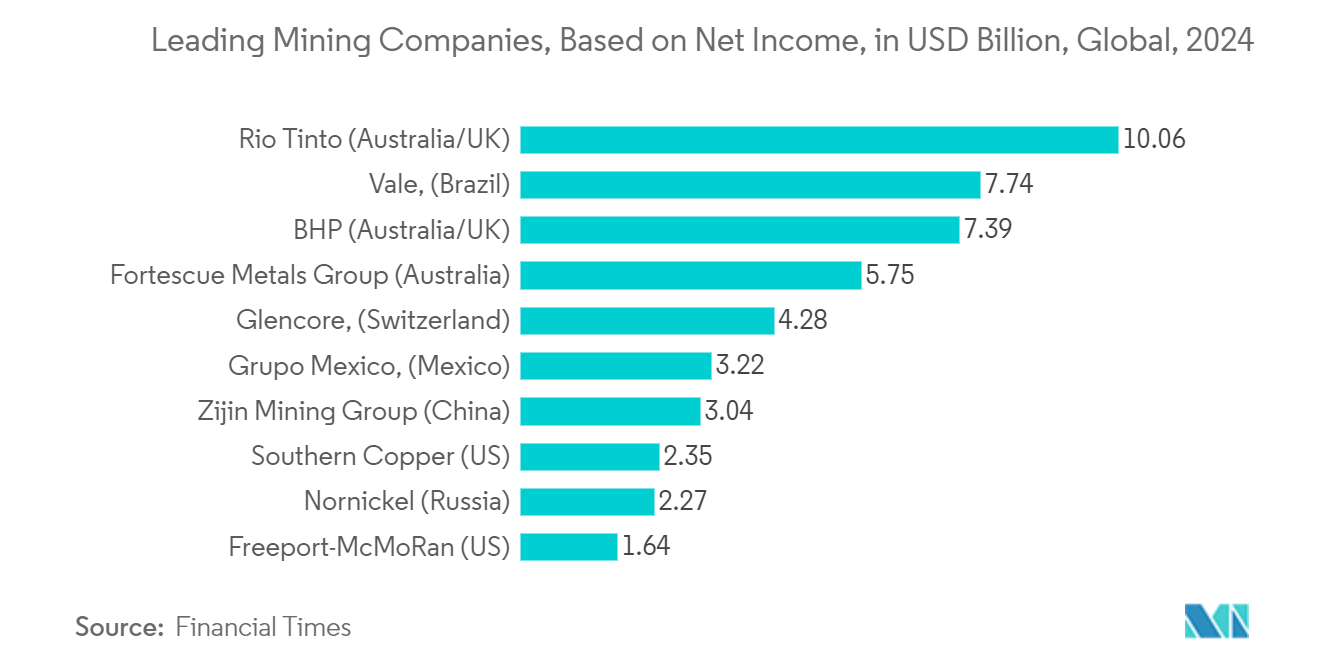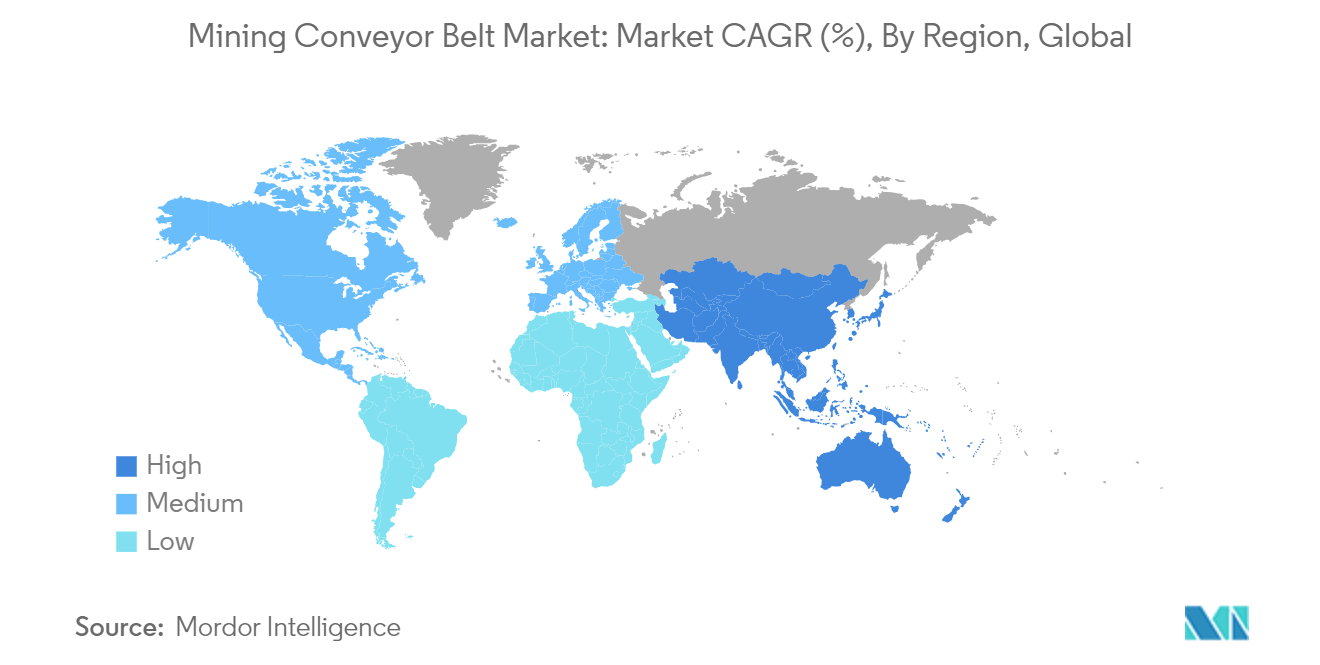Mining Conveyor Belt Market Size

| Study Period | 2019 - 2029 |
| Market Size (2024) | USD 1.89 Billion |
| Market Size (2029) | USD 2.28 Billion |
| CAGR (2024 - 2029) | 3.80 % |
| Fastest Growing Market | Asia Pacific |
| Largest Market | Asia Pacific |
Major Players
*Disclaimer: Major Players sorted in no particular order |
Mining Conveyor Belt Market Analysis
The Conveyor Belt Market In Mining Industry is expected to grow from USD 1.89 billion in 2024 to USD 2.28 billion by 2029, at a CAGR of 3.80% during the forecast period (2024-2029).
The demand is boosted owing to increasing government initiatives and the number of coal mines in countries such as India. For instance, during the second pandemic wave, the Technology Roadmap document released by Coal India outlines that conveyors that may handle coal up to 4,500 tph/hr have been planned in Coal India. Conventional conveyors are limited to inclined angles around 16 to 18 degrees. The focus on upgrading the mines with advanced conveyor belts is aiding the market's growth.
- In mining industry practices, the required output is desired, and the mining operator specifies rotary speed as a design parameter, determining the heat to be dissipated. This may strongly influence the dimensioning processes. This resulted in operating conditions that make a gear unit advisable larger than the output originally necessitates. If the conveyor belts operate in climatic zones that are unusually warm or even prone to extreme heat-cold fluctuations, much attention must be paid to cooling. For this reason, Siemens developed correspondingly efficient cooling solutions for its three gear-unit series, comprising 46 conveyor belt drive sizes. Therefore, in various cases, a smaller gear unit may be sufficient.
- India's journey toward becoming a developed nation by 2047 depends on improving its infrastructure. This is a cornerstone for fostering liveable, climate-resilient, and inclusive cities that drive economic growth. The government's commitment is evident through its allocation of 3.3% of GDP to the infrastructure sector in the fiscal year 2024, focusing on building high-end industrial segments.
- Ensuring occupational health and safety is a top priority in the mining industry. Mining operations are inherently challenging and pose various hazards and risks to workers. By prioritizing safety and implementing effective safety measures, companies may protect their workers, prevent accidents and injuries, and contribute to the overall sustainability of their operations.
- The mining industry operates under critical regulations and standards to ensure safety, environmental protection, and responsible practices. These include mine safety and health regulations, such as the Mine Safety and Health Administration (MSHA) in the United States.
- High initial costs have been the primary reason for restricting the use of automated material-handling systems, including conveyor belts and systems, to only large-scale organizations. At the same time, their long-term benefits are also considered. Small—and medium-scale enterprises may not benefit from this bargain. These systems require high levels of maintenance.
- Besides the direct impact on various market verticals, the global pandemic is also anticipated to have a long-term effect. For instance, since the pandemic, economies of multiple countries, which feel significant, are still unable to recover as anticipated, bringing a shadow of economic recession, especially in North American and European regions.
- For instance, according to the International Monetary Fund (IMF) estimates, the US real GDP growth is anticipated to remain slowed until 2024 before regaining momentum. Such trends may slow down the market by reducing investments in new metal and mining plants.
- According to the International Monitory Fund's (IMF's) July 2023 update, global economic growth was anticipated to fall from 3.5% in 2022 to about 3% in both 2023 and 2024 owing to the rising central bank policy rates to fight inflation, which is slowing down economic activities.
Mining Conveyor Belt Market Trends
Textile-reinforced Conveyor Belts to Witness Significant Growth
- Conveyor belts with textile reinforcement are typically used for abrasive and heavy-duty goods. They are a more affordable alternative to steel cord belts for shorter transporting distances and lesser capacities. The textile-reinforced conveyor belt is ideal for mining, mineral processing, and quarrying sectors. It may be blended with many different qualities, such as covers that are grease, heat, abrasion, impact, and fire-resistant quality. There are four basic types of construction for reinforcing high-strength belts: cord fabrics, straight warp fabrics, solid woven fabric, and cabled cords.
- The internal structure of a fabric belt carcass or textile consists of a single or multi-layered series of synthetic fabric layers interlaced between rubber-based shock-absorbent layers. The top and bottom sides of the belt consist of hard-wearing, abrasion, and cut-resistant rubber covers. The covers protect the belt from damage, especially at the loading points of the conveyor. This provides the tensile strength to the conveyor belt used in the mining industry.
- The strength, extension, and flexibility of synthetic fibers used in technical woven fabrics are higher than natural fibers used earlier. The primary fibers are cotton, viscose rayon, nylon, polyester, glass, and aramid. The aramid tenacity is seven times that of steel, and aramid is lighter than steel. It resists temperatures of 400-500 ºC, dampness, and chemicals and has high abrasion resistance. Thus, it is used in mining conveyor belts. Its strength significantly influences the mining industry's carrying capacity and operating safety of conveyor belts. Therefore, materials like textile-reinforced conveyor belts are anticipated to become more prevalent to boost the conveyor belt's strength.
- The belting manufacturers supply tables for fabric belting, reflecting the number of plies proposed for a belt based on the different types and grades of materials to be transported on the belt. The fabric is better than steel reinforcement in conveyor belts as textiles make it much more flexible, high-strength, energy-efficient, corrosion-resistant, and lightweight.
- With rising mining activities across several regions and increased investments in the mining industry, the need for textile-reinforced conveyor belts is expected to rise in the forecast period.

Asia-P acific to Register Major Growth
- The government's ambitious 'Made in China 2025' initiative, partially inspired by Germany, for Industry 4.0 aims to boost the country's competitiveness in the industrial sector. The ten-year plan, introduced in May 2015, is the government's bid to shift the industries up to the medium-high end of the global industry value chain and foster several advanced manufacturing clusters. The increase in industrialization will grow the market for conveyor belt solutions for the mining sector.
- In April 2024, according to the National Development and Reform Commission, China announced it would build more coal mines to push for higher domestic supply and tame price increases. The world's biggest coal producer and consumer set targets to add about 300 million tons of annual mining capacity for "emergency storage reserves" by 2030.
- The increased government's infrastructure investments and investments from industries, coupled with the 'Make in India' initiative, are expected to drive the market studied. The Government of India increased the industrial sector's share of the gross domestic product (GDP) to 25% by 2022, from 17% in 2018.
- In February 2024, Indian state-run company Coal India announced it would begin operations at five new coal mines and expand the capacity of at least 16 existing mines to help meet the growing demand for fossil fuel. The miner plans to start operations at five new mines in the next fiscal year, with a combined annual capacity of 14.3 mt. These developments in the mining sector in India are likely to drive the market studied in the region.

Mining Conveyor Belt Industry Overview
The mining conveyor belt market is highly fragmented due to the presence of small and medium-sized enterprises and global players. Some of the major players in the market are Sanwei Holding Group Co. Ltd, Fenner Dunlop Australia Pty Ltd (Michelin Group), Bando Chemical Industries Ltd, Contitech Deutschland GMBH (continental AG), and Tenova SPA (Techint Group). Players in the market are adopting strategies such as acquisitions and partnerships to enhance their product offerings and gain sustainable competitive advantage.
- January 2024 - Fenner Dunlop BV and Fenner Dunlop Americas announced they would merge under the Fenner Dunlop Conveyor Belting brand starting January 1, 2024. The move aims to unify the brand across regions and divisions for a more robust global presence. Both divisions will trade under the Fenner Dunlop Conveyor Belting name, aligning their strategies for consistent branding. This change underscores the Fenner Group's commitment to enhanced coordination and market impact.
- November 2023 - Gebr. Kufferath AG announced the successful certification from IATF 16949 for the Dürensite. The certification confirms GKD's commitment to the highest quality standards in various industries.
Mining Conveyor Belt Market Leaders
-
Sanwei Holding Group Co. Ltd
-
Fenner Dunlop Australia Pty Ltd (Michelin Group)
-
Bando Chemical Industries Ltd
-
ContiTech Deutschland GmbH (Continental AG)
-
Tenova SpA (Techint Group)
*Disclaimer: Major Players sorted in no particular order

Mining Conveyor Belt Market News
- April 2024 - Fenner Dunlop announced the rebranding of its premium X Series conveyor belting products, UsFlex, Nova-X, and Ultra X (formerly Patriot X). The X Series was developed to solve the everyday challenges conveyor operators encounter using traditional plied belting, explicitly aiming to alleviate pain points such as premature damage. X Series belts provide unmatched load support and exceptional troughability while operating at equivalent tension ratings to traditional plied belting.
- April 2024 - Abu Dhabi-based company ADQ signed a finance framework agreement with Kenya to enable investments in priority sectors of its economy. The Kenyan mining sector offers significant growth potential with its abundant reserves of gold, copper, ilmenite, tantalum, and various non-metallic minerals. The latest agreement, signed between UAE’s Ministry of Investment and Kenya’s Ministry of Finance and National Treasury, focuses on mineral exploration, processing and marketing, and mine development. These developments by the vendors in the market are expected to drive the market studied in the region.
Mining Conveyor Belt Market Report - Table of Contents
1. INTRODUCTION
- 1.1 Study Assumptions and Market Definition
- 1.2 Scope of the Study
2. RESEARCH METHODOLOGY
3. EXECUTIVE SUMMARY
4. MARKET INSIGHTS
- 4.1 Market Overview
- 4.2 Industry Value Chain Analysis
-
4.3 Industry Attractiveness - Porter's Five Forces Analysis
- 4.3.1 Bargaining Power of Suppliers
- 4.3.2 Bargaining Power of Buyers
- 4.3.3 Threat of New Entrants
- 4.3.4 Threat of Substitutes
- 4.3.5 Intensity of Competitive Rivalry
- 4.4 Impact of COVID-19 Aftereffects and Other Macroeconomic Trends on the Market
- 4.5 Various Types of Conveyor Solutions for Various Payloads Handled in the Mining Industry
- 4.6 Average Cost for Conveyor Systems in a Mining Setup
5. MARKET DYNAMICS
-
5.1 Market Drivers
- 5.1.1 Rise in Infrastructure Development and the Building Industry
- 5.1.2 Increased Emphasis on Workplace Safety
-
5.2 Market Restraints
- 5.2.1 High Capital Requirements and Unavailability for Skilled Workforce
- 5.3 Assessment of the Impact of COVID-19 on the Industry
6. MARKET SEGMENTATION
-
6.1 By Type
- 6.1.1 Steel Cord
- 6.1.2 Textile Reinforced
- 6.1.3 Other Types
-
6.2 By Geography***
- 6.2.1 North America
- 6.2.2 Europe
- 6.2.3 Asia
- 6.2.4 Australia and New Zealand
- 6.2.5 Latin America
- 6.2.6 Middle East & Africa
7. COMPETITIVE LANDSCAPE
-
7.1 Company Profiles*
- 7.1.1 Sanwei Holding Group Co. Ltd
- 7.1.2 Fenner Dunlop Australia Pty Ltd (Michelin group)
- 7.1.3 Bando Chemical Industries Ltd
- 7.1.4 ContiTech Deutschland GmbH (Continental AG)
- 7.1.5 Tenova SpA (Techint Group)
- 7.1.6 Dynamic Rubbers Pvt. Ltd
- 7.1.7 Oriental Rubber Industries Pvt. Ltd
- 7.1.8 Zhejiang Double Arrow Rubber Co. Ltd
- 7.1.9 Bridgestone Corporation
- 7.1.10 GKD Gebr. Kufferath AG
8. INVESTMENT ANALYSIS
9. MARKET OPPORTUNITIES AND FUTURE TRENDS
** Subject To AvailablityMining Conveyor Belt Industry Segmentation
Conveyor belts are essential for automation systems in various industries, including mining, because they cut down on operational costs and time. They are also essential for moving minerals to processing facilities in the mining industry. The revenue accrued from conveyor belt companies across geographies is used to estimate the market.
The conveyor belt market in the mining industry is segmented by type (steel cord, textile reinforced, and other types) and geography (North America, Europe, Asia-Pacific, Latin America, and the Middle East & Africa). The report offers market forecasts and size in value (USD) for all the above segments.
| By Type | Steel Cord |
| Textile Reinforced | |
| Other Types | |
| By Geography*** | North America |
| Europe | |
| Asia | |
| Australia and New Zealand | |
| Latin America | |
| Middle East & Africa |
Mining Conveyor Belt Market Research FAQs
How big is the Conveyor Belt Market In Mining Industry?
The Conveyor Belt Market In Mining Industry size is expected to reach USD 1.89 billion in 2024 and grow at a CAGR of 3.80% to reach USD 2.28 billion by 2029.
What is the current Conveyor Belt Market In Mining Industry size?
In 2024, the Conveyor Belt Market In Mining Industry size is expected to reach USD 1.89 billion.
Who are the key players in Conveyor Belt Market In Mining Industry?
Sanwei Holding Group Co. Ltd, Fenner Dunlop Australia Pty Ltd (Michelin Group), Bando Chemical Industries Ltd, ContiTech Deutschland GmbH (Continental AG) and Tenova SpA (Techint Group) are the major companies operating in the Conveyor Belt Market In Mining Industry.
Which is the fastest growing region in Conveyor Belt Market In Mining Industry?
Asia Pacific is estimated to grow at the highest CAGR over the forecast period (2024-2029).
Which region has the biggest share in Conveyor Belt Market In Mining Industry?
In 2024, the Asia Pacific accounts for the largest market share in Conveyor Belt Market In Mining Industry.
What years does this Conveyor Belt Market In Mining Industry cover, and what was the market size in 2023?
In 2023, the Conveyor Belt Market In Mining Industry size was estimated at USD 1.82 billion. The report covers the Conveyor Belt Market In Mining Industry historical market size for years: 2019, 2020, 2021, 2022 and 2023. The report also forecasts the Conveyor Belt Market In Mining Industry size for years: 2024, 2025, 2026, 2027, 2028 and 2029.
Mining Conveyor Belt Industry Report
The report on the mining conveyor belt market provides a comprehensive industry analysis segmented by type and geography. The industry report covers steel cord, textile reinforced, and other types of conveyor belts. The market research includes regions such as North America, Europe, Asia-Pacific, Latin America, and the Middle East & Africa. The market report offers insights into market size, market share, and market trends, providing a detailed market overview. The report also includes a market forecast, highlighting the market growth expected in the coming years.
The industry research delves into the market segmentation, offering a clear view of the market value. The market outlook is supported by industry statistics and market data, ensuring a thorough market analysis. The report example provides a snapshot of the industry sales and market predictions, making it a valuable resource for research companies.
The industry information includes a historical overview and a forecast outlook, which helps in understanding the market dynamics. The report pdf is available for download, providing a detailed market review. The industry outlook identifies the market leaders and highlights the industry trends that are shaping the market growth. The industry reports are essential for understanding the market segmentation and the market forecast.
Overall, the report is a crucial tool for anyone interested in the mining conveyor belt market, offering a detailed analysis of the industry size, market value, and market segmentation. The market data and industry statistics provide a solid foundation for market predictions and industry trends.



